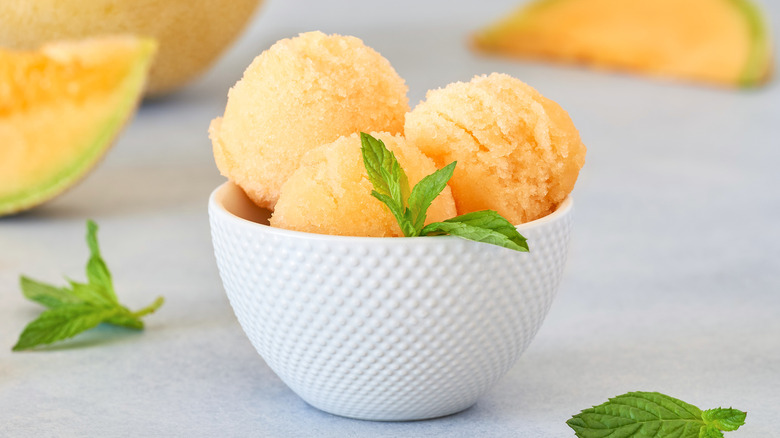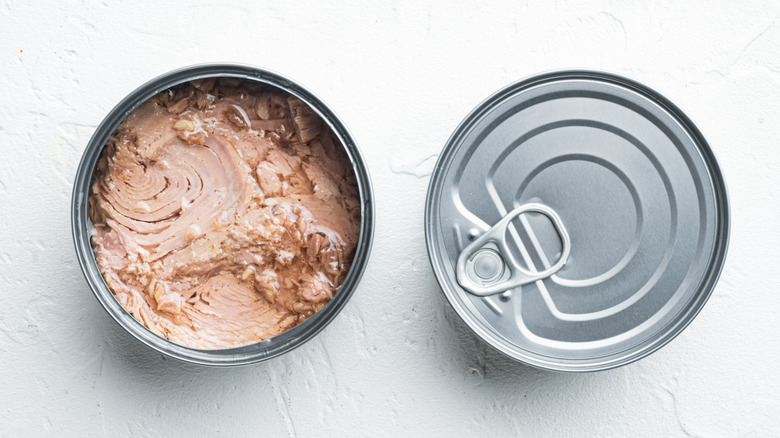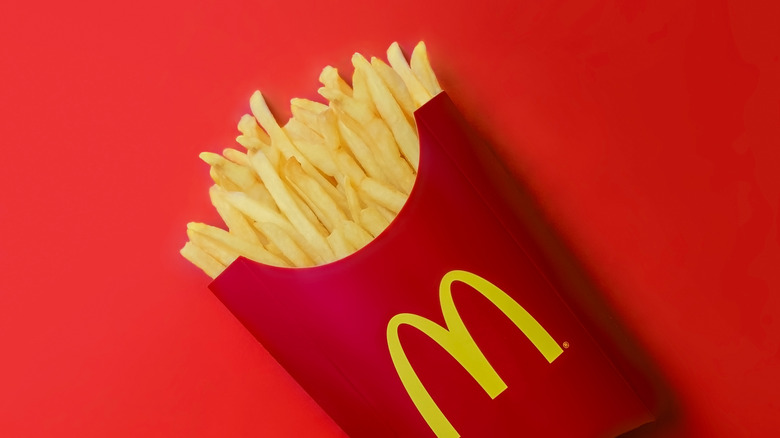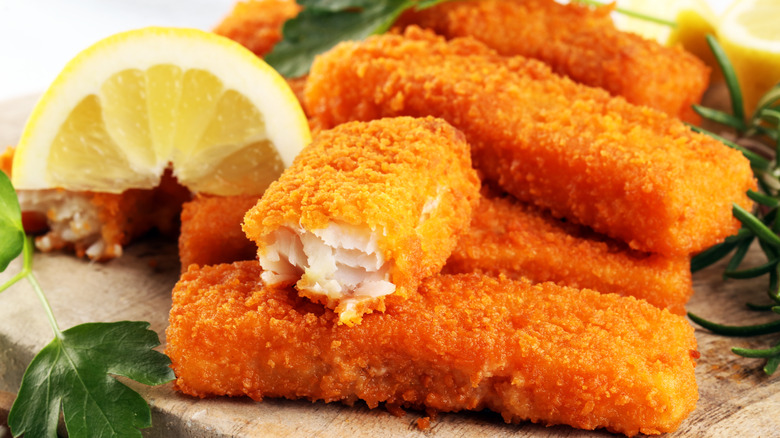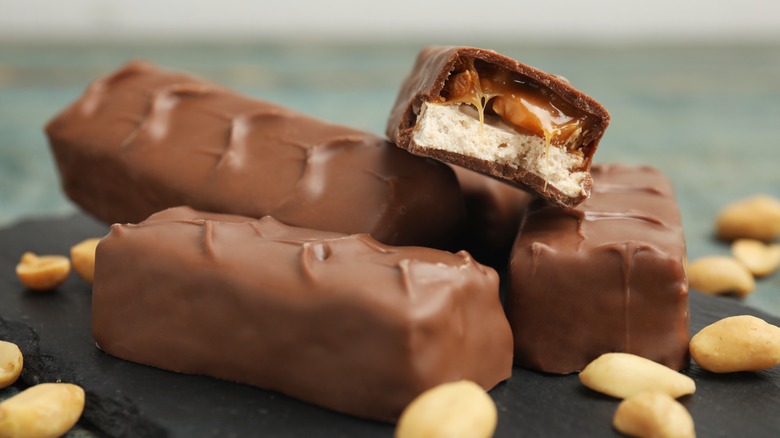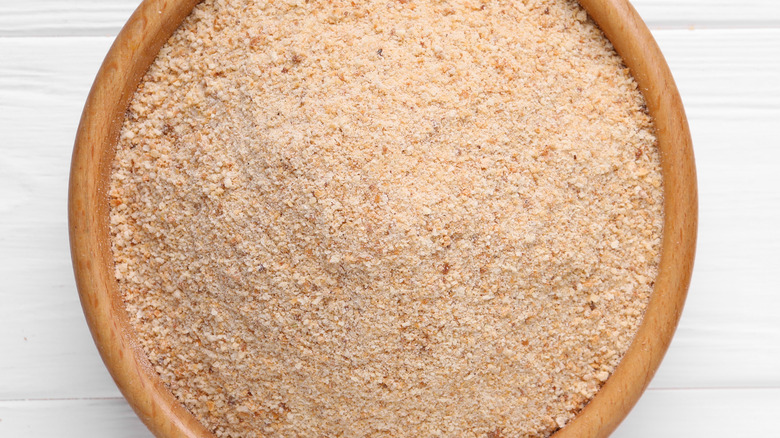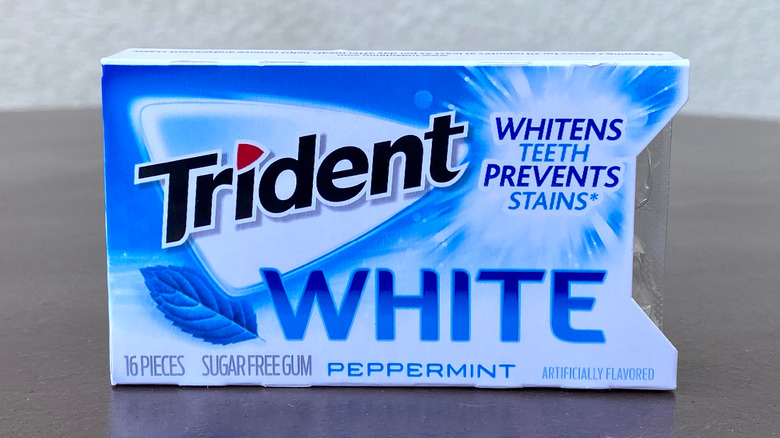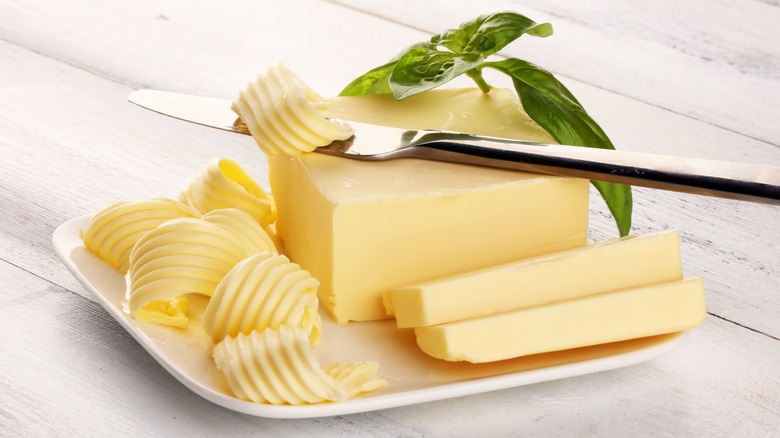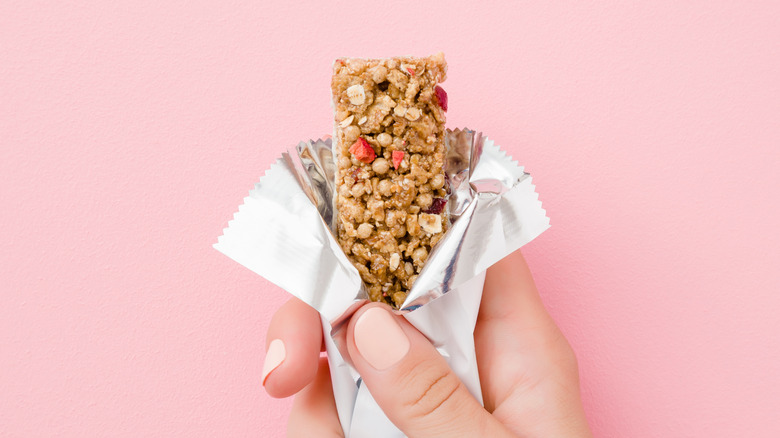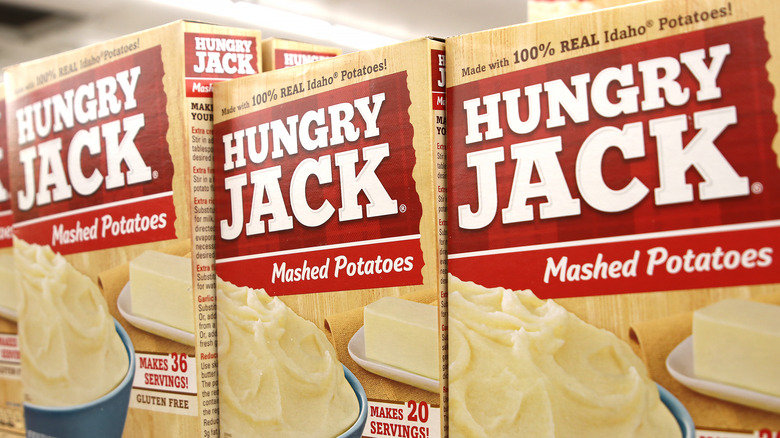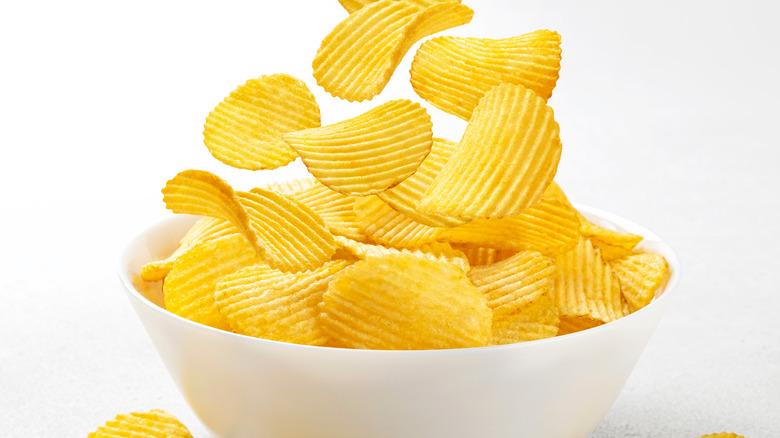Unexpected Foods That Contain Dairy
Few food products have as complicated a reputation as those made with dairy. Dairy foods were once a staple of every fridge in the country, with a daily carton of milk a firm fixture in kids' everyday lives. But an increasing awareness of the effects of products made with dairy — and the lactose contained within them — has caused people to rethink. There's a good reason for that, too.
Lactose intolerance, characterized by the presence of digestive issues after eating lactose-containing foods, may affect up to two-thirds of the world's population, according to research published in Nutrients. And more profound allergic reactions to cow's milk are on the rise as well, particularly among children, with milk increasingly causing more severe allergic responses (such as life-threatening anaphylaxis) than nuts in the United States (per WebMD). But surely, if you have lactose intolerance or a dairy allergy, then all you have to do is stop drinking milk, right? Well ... not quite.
A huge problem lies in the fact that there's dairy in a lot of things. "People do not think about how much of this is in our food," says the Texas Children's Hospital food allergy program director Carla Davis. In various forms, dairy can show up in the sneakiest of places — and we're here to give you the lowdown on where.
Lactose-free milk
As a product designed to be friendly to people with lactose intolerance, you might assume that lactose-free milk goes the whole hog and removes dairy, too. But be warned: This is often not the case.
Lactose-free milk is still a dairy product made from cow's milk, with the difference being that it has had lactase added to it, says Healthline. Lactase, the enzyme that works to break down lactose in the body, is produced by people who can tolerate lactose, but not by those with lactose intolerance.
However, unless your lactose-free milk is explicitly labeled as "vegan," in all likelihood, it'll still contain dairy. This makes it intolerable, and potentially dangerous, to anyone who has a dairy allergy. It's important to note that this is different from lactose intolerance. Whereas lactose intolerance is a digestive condition that can cause discomfort but is generally mild, a dairy allergy causes your immune system to respond to dairy proteins with an allergic reaction (per WebMD). Dairy allergies can range from producing a mild response to a life-threatening one. This should be taken very seriously if you or someone you know is experiencing allergic symptoms like a rash, wheezing, trouble swallowing, or hives.
Deli meat
Meat and dairy are generally treated as two distinct food groups, but when they come together, it can be a match made in heaven (cheeseburger, anyone?). However, if you're looking to avoid dairy, then the inclusion of it in meat products becomes less fun. And surprisingly, deli meat can have dairy lurking in it more frequently than you think, says Columbia University dietetic intern and "The Full Helping" author Gena Hamshaw (via Reader's Digest).
Dairy products can be used to bind the meat together, with lactose and caseinates, compounds that are made from the casein that comes in cow's milk (per Healthline), showing up in your salami and ham with alarming regularity. The easiest way to avoid this is simply by checking the label if you're buying pre-packaged deli meat: Anything that contains milk is a no-go for dairy dodgers. If you can't find the nutritional information, however, or are buying from a deli, seek out kosher products, which will omit dairy from their recipes.
More generally, though, it's a good idea to opt for unprocessed meat as a replacement for deli meats. With the high sodium and saturated fat levels in processed meat products, as well as the potential for various additives, eating deli meats frequently may contribute to higher blood pressure levels and an increased risk of cancer, says the Cleveland Clinic.
Sherbet
So if you're trying to avoid dairy, it's pretty obvious that eating ice cream is a no-go. But what about other frozen deserts? Surely sorbet and sherbet, the less dairy-fied siblings of ice cream, are good to eat, right?
Unfortunately, that's where you're wrong — and it's all in the important distinction between the three. Sherbet is, vitally, not dairy-free, according to The Kitchn. Sherbet generally has a little cream mixed into it to give it a slightly richer texture than sorbet, which is mainly made of just fruit and sugar. Sherbet can also have milk and buttermilk mixed into it, as well as additional food products like egg whites or gelatin. This means that sherbet is, like sorbet, on the lighter side in terms of fat content, as opposed to ice cream, which is cream-heavy. However, those with dairy allergies may want to avoid it entirely.
There's a simple solution to this, though: Just opt for sorbet! The desert is totally dairy-free, and will still give you that refreshing zing you need at the end of a big meal.
Tuna
Wait ... what? How can tuna, a product that's a world apart from cow's milk and yogurt, contain dairy? Well folks, unfortunately, it can be the case that the can of fish you've picked up contains some sneaky dairy.
Some brands of canned tuna may have casein in them, one of the main proteins in milk (the other being whey), as Verywell Fit states. This casein may come in the form of hydrolyzed caseinate, which acts as a flavor enhancer for the fish, says Neocate.
Casein can sometimes slip under the radar as a dairy product, but if you're trying to avoid the food group, particularly because of an allergy, it's vital to check the label. Consuming casein proteins with a dairy allergy causes your immune system to go into overdrive, due to it perceiving the casein as a harmful invader in your body (per the Mayo Clinic). The histamines and associated substances that your immune system releases are what cause the potentially dangerous symptoms. Ideally, look for tuna brands that only have tuna in the ingredients list.
McDonald's fries
You might not think that a humble potato needs any dairy (well, unless you're in the market for a ranch dipping sauce, in which case all bets are off). But McDonald's has some slightly different ideas, with their classic fries containing, somewhat bafflingly, milk (per the McDonald's website). The milk comes from "hydrolyzed milk," according to the ingredients list for the fries, which involves breaking down milk proteins with water (via the Independent). This process adds a meatier flavor to the fries, which also contain wheat.
For McDonald's lovers outside the U.S., you may have slightly more luck with your french fries: Both the Canadian and UK versions of their famous fries are milk-free, although they do contain a surprisingly long list of ingredients for what is, essentially, a potato. If you can't live without your McDonald's fix, though, there are a good amount of options on the U.S. menu that are dairy-free, including Chicken McNuggets, the McPlant, and the classic Hamburger, as well as a range of dipping sauces (via Go Dairy Free). Just make sure you're requesting your buns without butter when you order, as some branches may add it to your bread before toasting it.
Fish sticks
When it comes to processed food, the ingredients lists can get pretty extensive. And this can lead to some unexpected additions to foods that you may not have put together.
Such is the case with fish sticks, which can often contain milk or dairy as an additional ingredient, as Gorton's Crunchy Breaded Fish Sticks do in the form of whey (per Gorton's). Whey can be added to a range of foods to bulk them out and add further layers of flavor or improve their texture, according to Science Learning Hub. Milk may also comprise part of the batter of certain fish stick brands, and fish and shellfish can sometimes be dipped in food during their preparation process to reduce a "fishy" smell, says Verywell Fit.
The inclusion of dairy may be a cause for heartbreak for anyone with lactose intolerance or a dairy allergy, but luckily, dairy-free fish sticks are a breeze to make at home. All it takes is throwing together some white fish fillets cut into strips, dipping them in a few whole eggs, coating them in flour and seasonings, spraying them with cooking spray, and then baking in a 350-degree oven for 15 minutes or so (per The Real Food Dietitians). Using almond and coconut flour, the recipe is also pleasingly gluten-free, and with a dairy-free tartar sauce made from mayo, dill pickles, lemon juice, and honey, you'll likely never want to buy fish sticks again.
Nougat
Generally, you wouldn't assume that candy has dairy in it: After all, with the extra-long shelf-life that these products sometimes contain, wouldn't anything made with dairy just, well, go bad? Nougat, however, is the exception to this. The chewy, fluffy substance that you find in the center of some candy bars may be made using milk powder, according to Verywell Fit.
It's worth pointing out that not all nougats contain milk or dairy products, though. Classic nougat recipes typically rely on using just a combination of nuts, honey, sugar, and egg whites (via BBC Good Food). And before you assume that the eggs in nougat take it back off the table for those avoiding dairy, it's important to point out that despite being frequently grouped into the dairy food group, eggs are not dairy, as Healthline explains. Quite simply, eggs don't contain lactose or milk proteins, and so they don't produce the same reactions in people who are lactose intolerant or have a dairy allergy. Naturally, though, if you're following a vegan diet and avoiding dairy because of this, eggs are best avoided as well, as an animal product.
Breadcrumbs
Bread is a tricky area for people who are avoiding dairy. Some recipes contain milk, some may contain yogurt, some may contain eggs (which are not dairy, but are often mistaken as such), and some are dairy-free. It's a minefield, and where it gets even more confusing is with packaged breadcrumbs.
The breadcrumbs you find in the store can contain a surprisingly high number of dairy ingredients, including dry milk powder, casein, butterfat, or whey, according to The Spruce. In particular, both whey and casein may cause an allergic reaction (per WebMD).
Certain brands of breadcrumbs may also contain dairy products in their flavorings, such as in the case of Great Value Italian Style Bread Crumbs from Walmart, which not only contains whey but grated pecorino romano cheese made from pasteurized sheep's milk. If you're concerned about the presence of dairy in breadcrumbs, using Japanese panko breadcrumbs will usually ensure you're going dairy-free — or make the breadcrumbs yourself, by blitzing some old bread in a food processor.
Chewing gum
What do you think chewing gum's made of? Sorta makes you think, right? Chewing gum is one of those things we can pop in our mouth without a second thought, but it's worth checking the ingredients label — especially because of the surprising presence of dairy in some popular brands.
Trident White, for example, contains a "Calcium Casein Peptone-Calcium Phosphate (Lactose-Free Milk Derivative)," more snappily known as Recaldent, in all of its flavors (per Drugs.com). Recaldent is a naturally-occurring protein that's extracted from cow's milk, and is added to oral health products like chewing gum and toothpaste to help repair enamel damage to the teeth caused by bacteria, says Oral Health CRC. As it's derived from milk, however, Recaldent can cause unpleasant reactions in people who have dairy allergies. Research published in the British Dental Journal even discusses two separate cases of people with dairy allergies who experienced anaphylaxis after using products containing Recaldent, resulting in the death of one of them.
Margarine
Margarine is a classic butter alternative that, by its very nature, should be dairy-free. Unfortunately, that's often not the case.
Although margarine is typically made by combining vegetable oils and water along with various colorings and flavorings to create a butter alternative, there are some kinds of margarine out there that are made with milk, according to Healthline. Certain margarine brands may also contain other dairy products, like casein, whey, or lactose, which makes them unsuitable not only for people following a vegan lifestyle, but also for anyone with a dairy allergy or lactose intolerance.
For that reason, it's important to be careful how you choose your spread. To be on the safe side, seek out options that explicitly market themselves as vegan and non-dairy, advises The Spruce Eats. It's also important to check the label for any allergen information or the presence of milk, casein, whey, or lactose. Smart Balance Light Margarine, Earth Balance, or Blue Bonnet Light Margarine are both good vegan options. You can also your hand at making your own, using coconut milk, vegetable oils, turmeric, and Dijon mustard (per The Spruce Eats).
Cereal and protein snack bars
If you're a fan of cereal but are avoiding dairy, you might think that snack bars are a good alternative: All of that cereal goodness with no milk. Alas, if only it were that simple.
Many cereal and protein snack bars available out there contain dairy in the form of whey protein, butterfat, casein, or milk powder, even when they're not the yogurt-coated kind, says The Spruce Eats. Interestingly, this is also the case with boxed cereals, which often rely on dairy products to boost flavor. Protein bars, too, often have dairy tucked away in them, usually in the form of whey protein to boost the muscle-building benefits of the snack. They can, and often do, also have other milk derivatives in them.
Not too promising, right? But the good news is, there are snack bars available that shun dairy entirely, while still remaining delicious. Options like Bob's Oat Bars, certain types of Kind Bars, Larabars, and Nature Valley Crunchy Bars are all great dairy-free options, according to Go Dairy Free. Nature Valley bars also get an added nutritional bonus, thanks to their being made with "100% wholegrain oats, making it a great, filling option for those looking for slow release energy that will keep you satisfied," says nutritionist and Formulate Health founder Mina Khan (via GoodtoKnow).
Instant mashed potatoes
Okay, so we don't think that instant mashed potato is high up on anyone's list of healthy foods. But at a basic level, you'd be forgiven for assuming that it's just, well, potato (albeit highly processed). Unfortunately, even instant mashed potato powders or flakes can contain dairy products.
Hungry Jack Mashed Potatoes, for example, lists milk under its allergens, as well as containing a fair amount of additional ingredients that you probably won't find in a regular potato from the grocery store (per Walmart). There's also the issue that instant mashed potatoes — and indeed, many non-instant mashed potato recipes — seem to require milk or cream to make them, further complicating how you get your potato fix on a dairy-free diet.
But never fear! Delicious, fluffy mash can still be yours, with a recipe that uses olive oil (via Budget Bytes). Simply boil up some russet potatoes until fork-tender, and while they're cooking, create a garlic infusion by briefly frying sliced garlic in olive oil. Remove the garlic, drain the potatoes, mix the two, and mash with vegetable broth, a little dried rosemary, salt, and pepper. Honestly, we don't think it gets much better than this.
Potato chips
There are few things more satisfying than the snap of a potato chip, and for dairy-free diet followers, it's easy to assume that chips are a safe bet. But a surprisingly large number of potato chip varieties have some kind of dairy in them, making it a minefield to get your fix.
Tastes that revolve around milk products, like sour cream and onion or cheese, often have some form of milk derivative in them, to give them appropriate flavor (per HuffPost). But even flavors like barbecue or ketchup may also contain lactose or other types of dairy, making it imperative to check before you buy.
Luckily, there are still chips out there that you can enjoy without the risk of dairy. Lay's potato chips have several flavors that are dairy-free, like Hot N' Spicy BBQ, Dill Pickle, and Sea Salt and Vinegar, according to Livestrong. Generally, you're also safe with the most simple of flavors, like classic salt or salt & pepper varieties. If you're feeling ambitious, too, you might want to try your hand at making your own potato chips, so that you can control the ingredients they contain.
Artificial sweeteners
The contents of artificial sweeteners are the source of much controversy, with a huge amount of discussion (and study) going into whether ingredients like aspartame are healthy (per Medical News Today). People who are avoiding eating dairy or milk products may want to question their artificial sweetener's contents for a different reason, though. Some brands of sachet or tablet sweetener, like Equal Classic Tablets or Splenda No Calorie Minis, can contain small amounts of lactose, according to Vancouver-based registered dietitian Desiree Nielsen (via Best Health).
However, for many folks, this may not be the worst thing in the world. Indeed, for many lactose-intolerant people, eating a little bit of lactose here and there may not produce any symptoms. For some, ingesting smaller amounts of lactose may even help the body adapt to better handle products containing the sugar. "If you keep eating dairy, you can stimulate some lactase production. That may help you better tolerate dairy products," advises the Mayo Clinic's division of gastroenterology and hepatology assistant professor Yuri A. Saito-Loftus (via WebMD). The most important thing, according to dietitian and Academy of Nutrition and Dietetics spokeswoman Dee Sandquist, is to pay close attention to your body's reaction when you eat lactose, to establish how much is too much.




